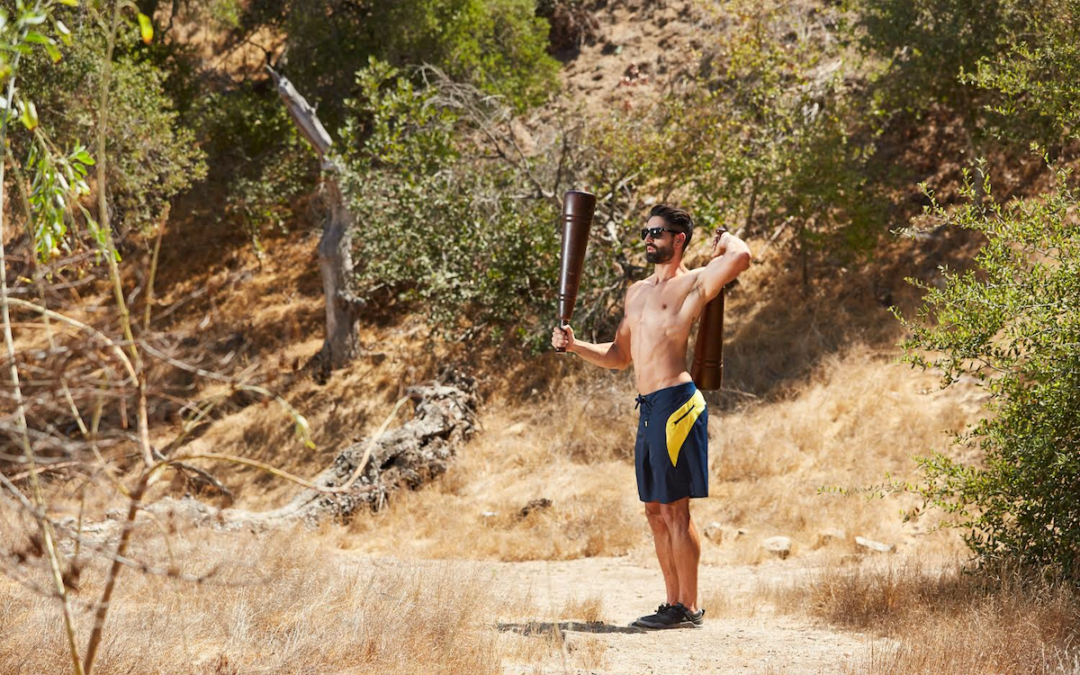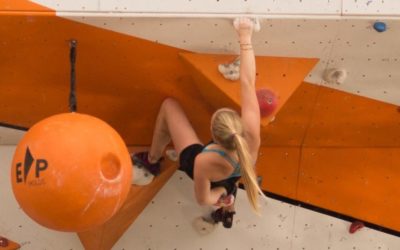Cross training with Indian Clubs can help you build stable and strong shoulders and reduce climbing-related injuries.
By John Parker, CSCS
As we climb to new heights, our success depends upon preparation. Invariably, routes get steeper and holds get smaller. To overcome these challenges, training off the wall must be oriented toward improving weaknesses.
As a strength coach, my job is to prepare athletes to meet the demands of their sport while reducing their chances of injury. I’ve found that using Indian Clubs for conditioning the joints of the shoulder, elbows, wrists, and fingers is a novel and effective method for training the climber.
Once a near-forgotten technique, there has been a resurgence in the ancient art of Indian Clubs. Formally a tool to train warriors, swinging clubs has become mainstream. Their off-balance design requires the user to handle centrifugal force while maintaining balance from the core outward. Indian Clubs offer multiple benefits:
- Shoulder Strength and Flexibility
- Grip and Forearm Strength
- Thoracic Spine Mobility
- Total Body Coordination
- Pre-habilitation and Rehabilitation
- Neuroplasticity

Indian Clubs come in a variety of sizes from 2lbs for the beginner and upwards of 10lbs for the advanced athlete. Their compact design allows them to easily fit in a backpack, but perhaps more importantly, makes them feel heavier than they actually are. Since their center of gravity is constantly changing during swinging patterns, Indian Clubs promote traction in the shoulder joint while stimulating the core to resist force.
How Do Indian Clubs Help the Climber?
In climbing, movement emanates from the core musculature. Emphasizing this demand, Indian Clubs challenge the user to harness their core strength and thoracic and transverse rotation while simultaneously moving their joints in rhythmic patterns.
I’ve seen many climbing training programs falter since their focus is often only sagittal plane (forward and backward) movement. When watching the climber, we see that movement is multiplanar; encompassing the sagittal, transverse, and frontal planes. In other words, sending a route requires the body to twist, move sideways, and travel forward/upward. The climber must engage in coordinated efforts no matter the axis of their movement.
Since Indian Clubs move in the sagittal, frontal, and transverse planes of the body, their use drives greater range of motion in overhead and near-reaching positions. This enhanced ability to harness strength from core to the shoulders and to the fingers builds confidence in awkward climbing sequences. Indian Clubs promote spatial awareness and heightened proprioception that’s critical to the advancing climber.
Not only do Indian Clubs promote physical preparation, they enhance mental acuity and neuroplasticity, which is defined as “the brain’s ability to reorganize itself by forming new neural connections.” By crossing the midline of the body in coordinated efforts, Indian Club training causes the brain to adapt to complex movement.
This means that supplementing climbing with Indian Club training helps us grow physically and mentally. Both of which are essential qualities of a well-rounded climber.
Each pattern with Indian Clubs becomes cemented into our movement patterns, just like in climbing. Daily Indian Club training allows the user to link patterns through coordinated transitions. What is the result? A fun form of exercise that relieves the body of climbing-associated inflammation, muscle tightness, and pain while helping our brains to stay and feel younger.
Climbers can use Indian clubs for their warm-up, shoulder and forearm conditioning, and cool-down to restore range of motion. Below are videos that demonstrate options for each. Keep in mind that due to the unique nature of the tools, I recommended getting some in-person training to ensure optimal form, technique and injury prevention strategies before trying them on your own.
Warm-up
Whether climbing in the gym or at the crag, a warm-up raises core body temperature while providing dynamic range of motion to the joints. Focusing on climbers, the warm-up must provide stimulus to the gripping musculature, elbows, shoulders, thoracic spine, and core.
Outward Front Circles
Inward Front Circles
Straight Arm Shoulder Warm-Up and Turns
Swing to Pullovers
Shoulder, Forearm, and Grip Conditioning
Enhancing the resiliency of the shoulder and forearms means improved ability to send steeper, longer, and harder climbs. I recommend that the beginner use the warm-ups listed above before their daily climb training. Post climbing, they should engage in these exercises for high repetitions.
Single and Double Inward Heart Shaped Swings
Single and Double Outward Heart Shaped Swings
Parallel Swings with Transverse Turns to the Left and Right
Cool-Down
Post-climbing, athletes should engage in a variety of stretching and mobility exercises to ensure proper recovery. Using the Indian Club for forearm wrist maintenance is a pragmatic way of building the small tendons and ligaments from the elbow to the fingers.
Ulnar and Radial Wrist Flexion with Club
Frontal Plane Wrist Rotations
Learn to Use Indian Clubs and Gada (Mace)
Although one can learn the aforementioned exercise with practice, I recommend seeking a qualified Indian Club coach to ensure accuracy in form. With the help of Mesa Rim, I will co-host an Indian Club and Gada (mace) workshop with world-renown coach, Paul Wolkowinski, on April 20, 2019 at the Mesa Rim Climbing Academy.
This workshop is ideal for newcomers to the Gada (mace) and also those who have been training but want to refine and perfect their technique.
You can learn more about that workshop here.


